key FIAT DUCATO BASE CAMPER 2015 Owner handbook (in English)
[x] Cancel search | Manufacturer: FIAT, Model Year: 2015, Model line: DUCATO BASE CAMPER, Model: FIAT DUCATO BASE CAMPER 2015Pages: 367, PDF Size: 19.73 MB
Page 186 of 367
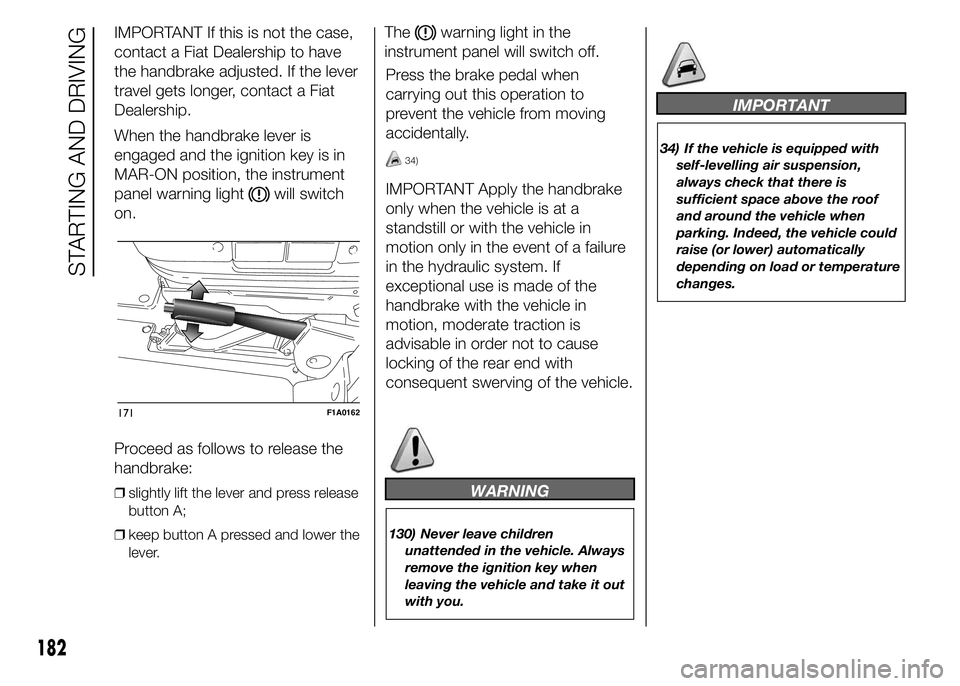
IMPORTANT If this is not the case,
contact a Fiat Dealership to have
the handbrake adjusted. If the lever
travel gets longer, contact a Fiat
Dealership.
When the handbrake lever is
engaged and the ignition key is in
MAR-ON position, the instrument
panel warning light
will switch
on.
Proceed as follows to release the
handbrake:
❒slightly lift the lever and press release
button A;
❒keep button A pressed and lower the
lever.
Thewarning light in the
instrument panel will switch off.
Press the brake pedal when
carrying out this operation to
prevent the vehicle from moving
accidentally.
34)
IMPORTANT Apply the handbrake
only when the vehicle is at a
standstill or with the vehicle in
motion only in the event of a failure
in the hydraulic system. If
exceptional use is made of the
handbrake with the vehicle in
motion, moderate traction is
advisable in order not to cause
locking of the rear end with
consequent swerving of the vehicle.
WARNING
130) Never leave children
unattended in the vehicle. Always
remove the ignition key when
leaving the vehicle and take it out
with you.
IMPORTANT
34) If the vehicle is equipped with
self-levelling air suspension,
always check that there is
sufficient space above the roof
and around the vehicle when
parking. Indeed, the vehicle could
raise (or lower) automatically
depending on load or temperature
changes.
171F1A0162
182
STARTING AND DRIVING
Page 196 of 367
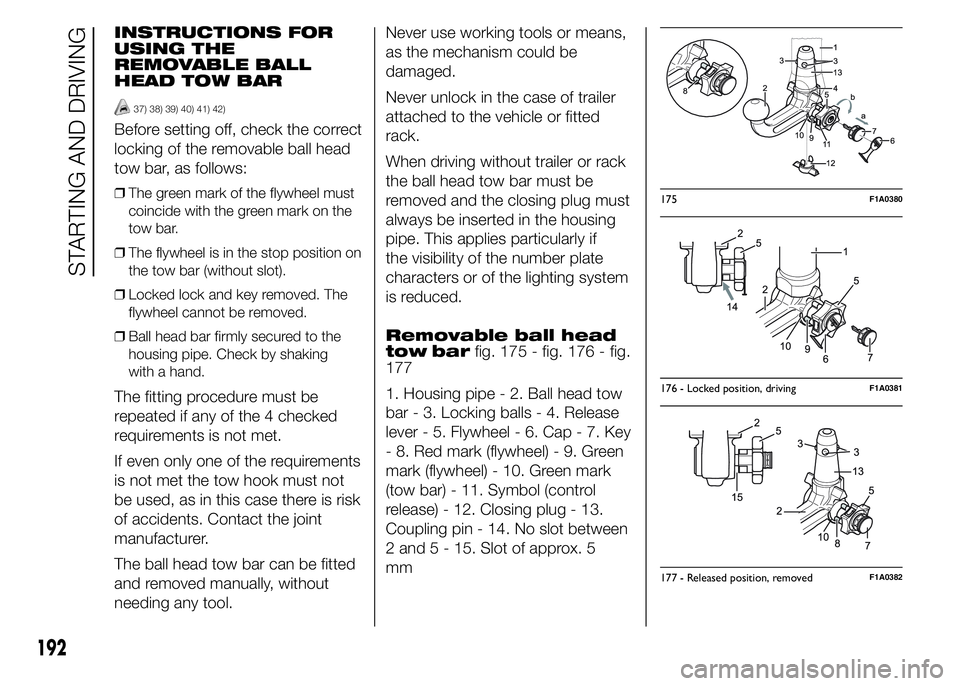
INSTRUCTIONS FOR
USING THE
REMOVABLE BALL
HEAD TOW BAR
37) 38) 39) 40) 41) 42)
Before setting off, check the correct
locking of the removable ball head
tow bar, as follows:
❒The green mark of the flywheel must
coincide with the green mark on the
tow bar.
❒The flywheel is in the stop position on
the tow bar (without slot).
❒Locked lock and key removed. The
flywheel cannot be removed.
❒Ball head bar firmly secured to the
housing pipe. Check by shaking
with a hand.
The fitting procedure must be
repeated if any of the 4 checked
requirements is not met.
If even only one of the requirements
is not met the tow hook must not
be used, as in this case there is risk
of accidents. Contact the joint
manufacturer.
The ball head tow bar can be fitted
and removed manually, without
needing any tool.Never use working tools or means,
as the mechanism could be
damaged.
Never unlock in the case of trailer
attached to the vehicle or fitted
rack.
When driving without trailer or rack
the ball head tow bar must be
removed and the closing plug must
always be inserted in the housing
pipe. This applies particularly if
the visibility of the number plate
characters or of the lighting system
is reduced.
Removable ball head
tow barfig. 175 - fig. 176 - fig.
177
1. Housing pipe - 2. Ball head tow
bar - 3. Locking balls - 4. Release
lever - 5. Flywheel - 6. Cap - 7. Key
- 8. Red mark (flywheel) - 9. Green
mark (flywheel) - 10. Green mark
(tow bar) - 11. Symbol (control
release) - 12. Closing plug - 13.
Coupling pin - 14. No slot between
2 and 5 - 15. Slot of approx. 5
mm
175F1A0380
176 - Locked position, drivingF1A0381
177 - Released position, removedF1A0382
192
STARTING AND DRIVING
Page 197 of 367
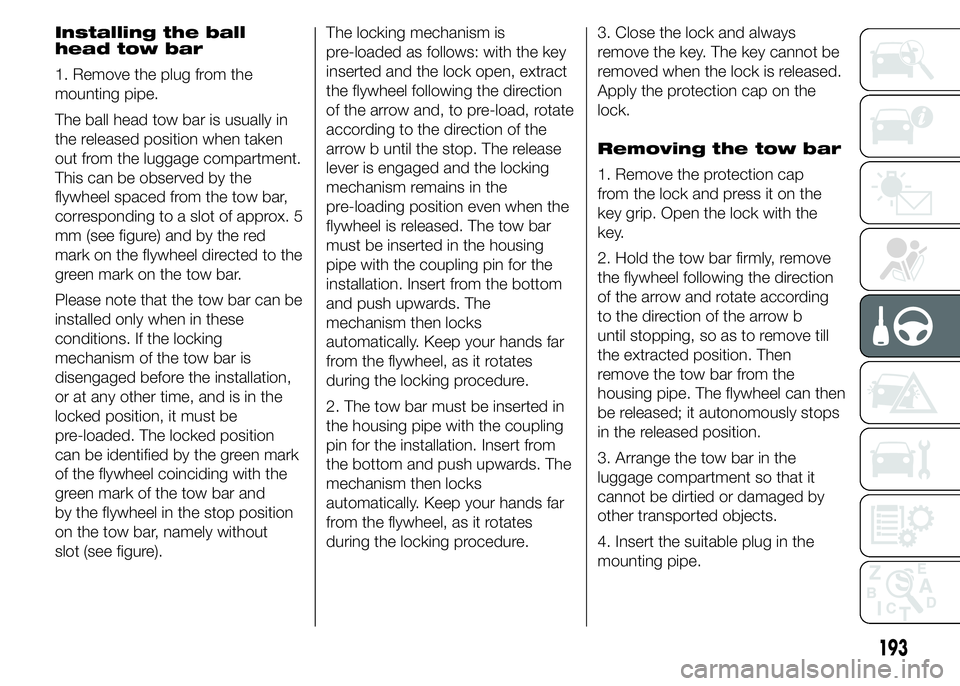
Installing the ball
head tow bar
1. Remove the plug from the
mounting pipe.
The ball head tow bar is usually in
the released position when taken
out from the luggage compartment.
This can be observed by the
flywheel spaced from the tow bar,
corresponding to a slot of approx. 5
mm (see figure) and by the red
mark on the flywheel directed to the
green mark on the tow bar.
Please note that the tow bar can be
installed only when in these
conditions. If the locking
mechanism of the tow bar is
disengaged before the installation,
or at any other time, and is in the
locked position, it must be
pre-loaded. The locked position
can be identified by the green mark
of the flywheel coinciding with the
green mark of the tow bar and
by the flywheel in the stop position
on the tow bar, namely without
slot (see figure).The locking mechanism is
pre-loaded as follows: with the key
inserted and the lock open, extract
the flywheel following the direction
of the arrow and, to pre-load, rotate
according to the direction of the
arrow b until the stop. The release
lever is engaged and the locking
mechanism remains in the
pre-loading position even when the
flywheel is released. The tow bar
must be inserted in the housing
pipe with the coupling pin for the
installation. Insert from the bottom
and push upwards. The
mechanism then locks
automatically. Keep your hands far
from the flywheel, as it rotates
during the locking procedure.
2. The tow bar must be inserted in
the housing pipe with the coupling
pin for the installation. Insert from
the bottom and push upwards. The
mechanism then locks
automatically. Keep your hands far
from the flywheel, as it rotates
during the locking procedure.3. Close the lock and always
remove the key. The key cannot be
removed when the lock is released.
Apply the protection cap on the
lock.
Removing the tow bar
1. Remove the protection cap
from the lock and press it on the
key grip. Open the lock with the
key.
2. Hold the tow bar firmly, remove
the flywheel following the direction
of the arrow and rotate according
to the direction of the arrow b
until stopping, so as to remove till
the extracted position. Then
remove the tow bar from the
housing pipe. The flywheel can then
be released; it autonomously stops
in the released position.
3. Arrange the tow bar in the
luggage compartment so that it
cannot be dirtied or damaged by
other transported objects.
4. Insert the suitable plug in the
mounting pipe.
193
Page 198 of 367
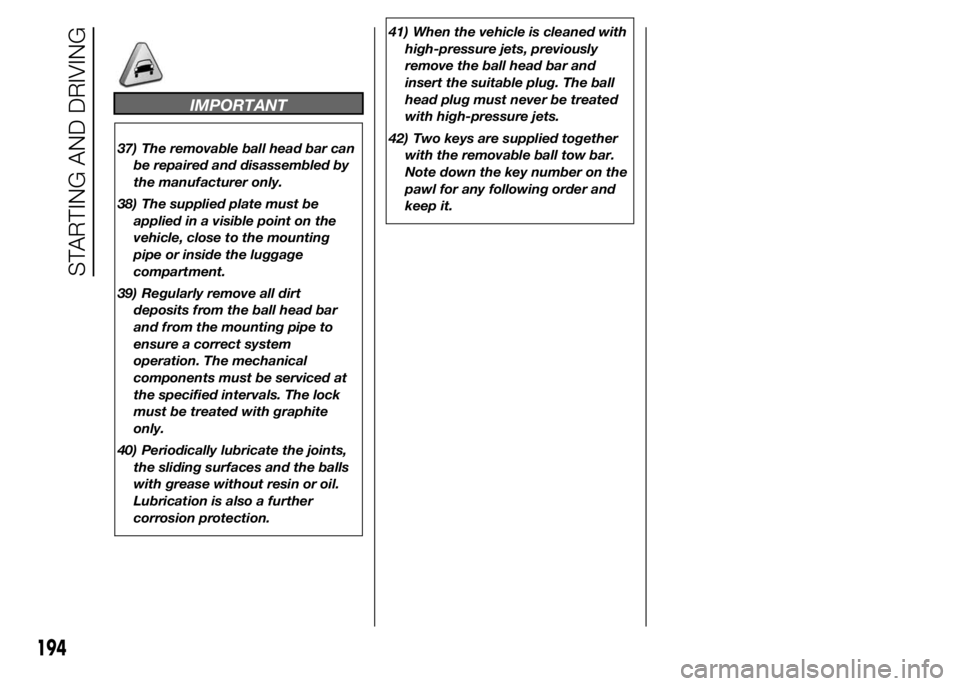
IMPORTANT
37) The removable ball head bar can
be repaired and disassembled by
the manufacturer only.
38) The supplied plate must be
applied in a visible point on the
vehicle, close to the mounting
pipe or inside the luggage
compartment.
39) Regularly remove all dirt
deposits from the ball head bar
and from the mounting pipe to
ensure a correct system
operation. The mechanical
components must be serviced at
the specified intervals. The lock
must be treated with graphite
only.
40) Periodically lubricate the joints,
the sliding surfaces and the balls
with grease without resin or oil.
Lubrication is also a further
corrosion protection.41) When the vehicle is cleaned with
high-pressure jets, previously
remove the ball head bar and
insert the suitable plug. The ball
head plug must never be treated
with high-pressure jets.
42) Two keys are supplied together
with the removable ball tow bar.
Note down the key number on the
pawl for any following order and
keep it.
194
STARTING AND DRIVING
Page 200 of 367
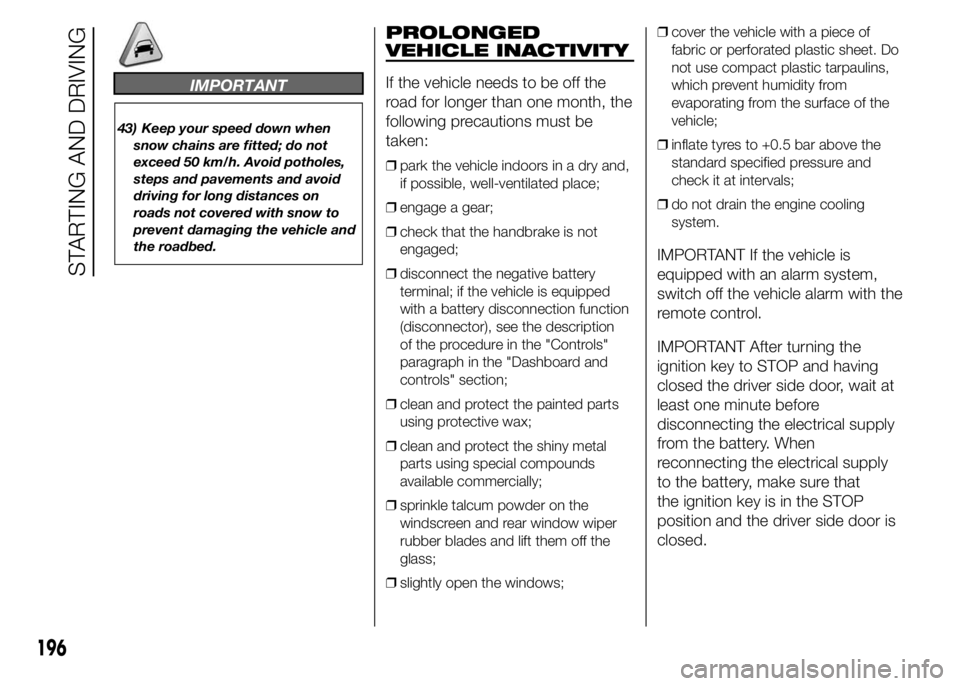
IMPORTANT
43) Keep your speed down when
snow chains are fitted; do not
exceed 50 km/h. Avoid potholes,
steps and pavements and avoid
driving for long distances on
roads not covered with snow to
prevent damaging the vehicle and
the roadbed.
PROLONGED
VEHICLE INACTIVITY
If the vehicle needs to be off the
road for longer than one month, the
following precautions must be
taken:
❒park the vehicle indoors in a dry and,
if possible, well-ventilated place;
❒engage a gear;
❒check that the handbrake is not
engaged;
❒disconnect the negative battery
terminal; if the vehicle is equipped
with a battery disconnection function
(disconnector), see the description
of the procedure in the "Controls"
paragraph in the "Dashboard and
controls" section;
❒clean and protect the painted parts
using protective wax;
❒clean and protect the shiny metal
parts using special compounds
available commercially;
❒sprinkle talcum powder on the
windscreen and rear window wiper
rubber blades and lift them off the
glass;
❒slightly open the windows;❒cover the vehicle with a piece of
fabric or perforated plastic sheet. Do
not use compact plastic tarpaulins,
which prevent humidity from
evaporating from the surface of the
vehicle;
❒inflate tyres to +0.5 bar above the
standard specified pressure and
check it at intervals;
❒do not drain the engine cooling
system.
IMPORTANT If the vehicle is
equipped with an alarm system,
switch off the vehicle alarm with the
remote control.
IMPORTANT After turning the
ignition key to STOP and having
closed the driver side door, wait at
least one minute before
disconnecting the electrical supply
from the battery. When
reconnecting the electrical supply
to the battery, make sure that
the ignition key is in the STOP
position and the driver side door is
closed.
196
STARTING AND DRIVING
Page 224 of 367
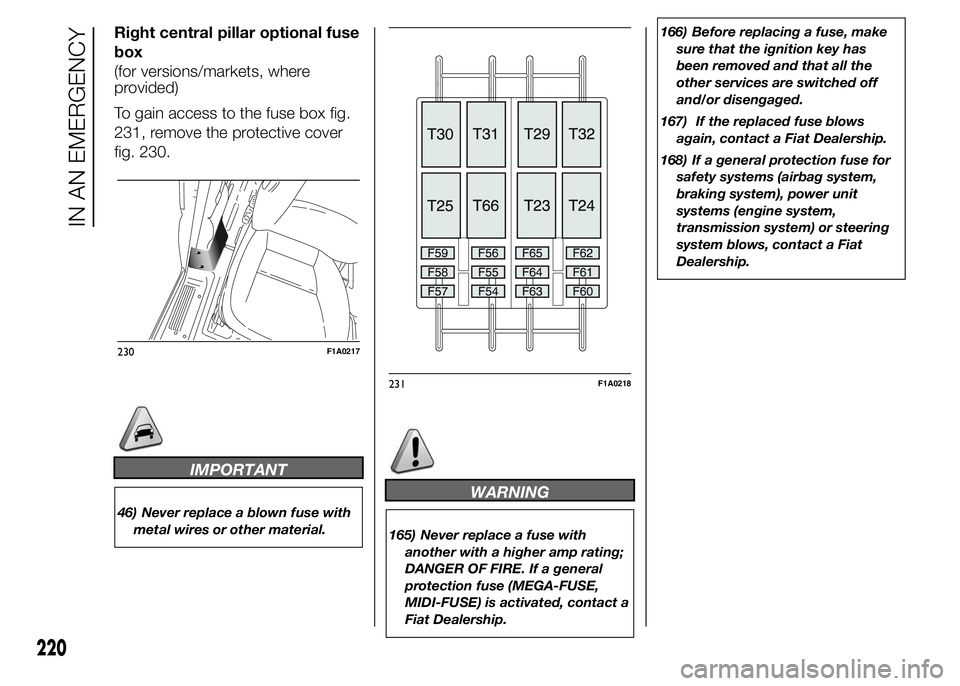
Right central pillar optional fuse
box
(for versions/markets, where
provided)
To gain access to the fuse box fig.
231, remove the protective cover
fig. 230.
IMPORTANT
46) Never replace a blown fuse with
metal wires or other material.
WARNING
165) Never replace a fuse with
another with a higher amp rating;
DANGER OF FIRE. If a general
protection fuse (MEGA-FUSE,
MIDI-FUSE) is activated, contact a
Fiat Dealership.166) Before replacing a fuse, make
sure that the ignition key has
been removed and that all the
other services are switched off
and/or disengaged.
167) If the replaced fuse blows
again, contact a Fiat Dealership.
168) If a general protection fuse for
safety systems (airbag system,
braking system), power unit
systems (engine system,
transmission system) or steering
system blows, contact a Fiat
Dealership.
230F1A0217
231F1A0218
220
IN AN EMERGENCY
Page 225 of 367
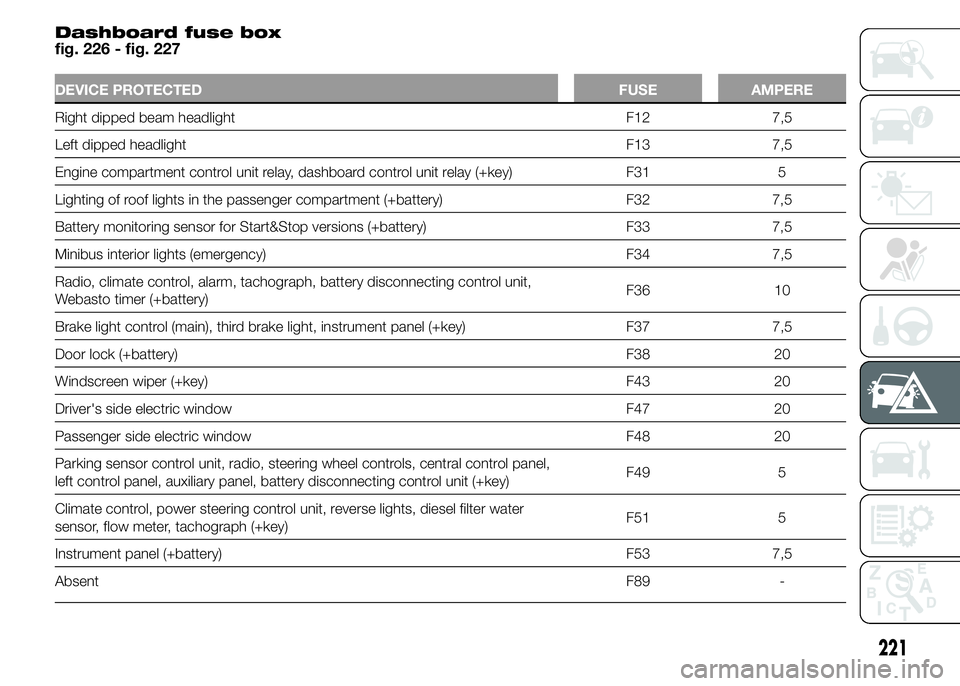
Dashboard fuse box
fig. 226 - fig. 227
DEVICE PROTECTED FUSE AMPERE
Right dipped beam headlight F12 7,5
Left dipped headlight F13 7,5
Engine compartment control unit relay, dashboard control unit relay (+key) F31 5
Lighting of roof lights in the passenger compartment (+battery) F32 7,5
Battery monitoring sensor for Start&Stop versions (+battery) F33 7,5
Minibus interior lights (emergency) F34 7,5
Radio, climate control, alarm, tachograph, battery disconnecting control unit,
Webasto timer (+battery)F36 10
Brake light control (main), third brake light, instrument panel (+key) F37 7,5
Door lock (+battery) F38 20
Windscreen wiper (+key) F43 20
Driver's side electric window F47 20
Passenger side electric window F48 20
Parking sensor control unit, radio, steering wheel controls, central control panel,
left control panel, auxiliary panel, battery disconnecting control unit (+key)F49 5
Climate control, power steering control unit, reverse lights, diesel filter water
sensor, flow meter, tachograph (+key)F51 5
Instrument panel (+battery) F53 7,5
AbsentF89 -
221
Page 227 of 367
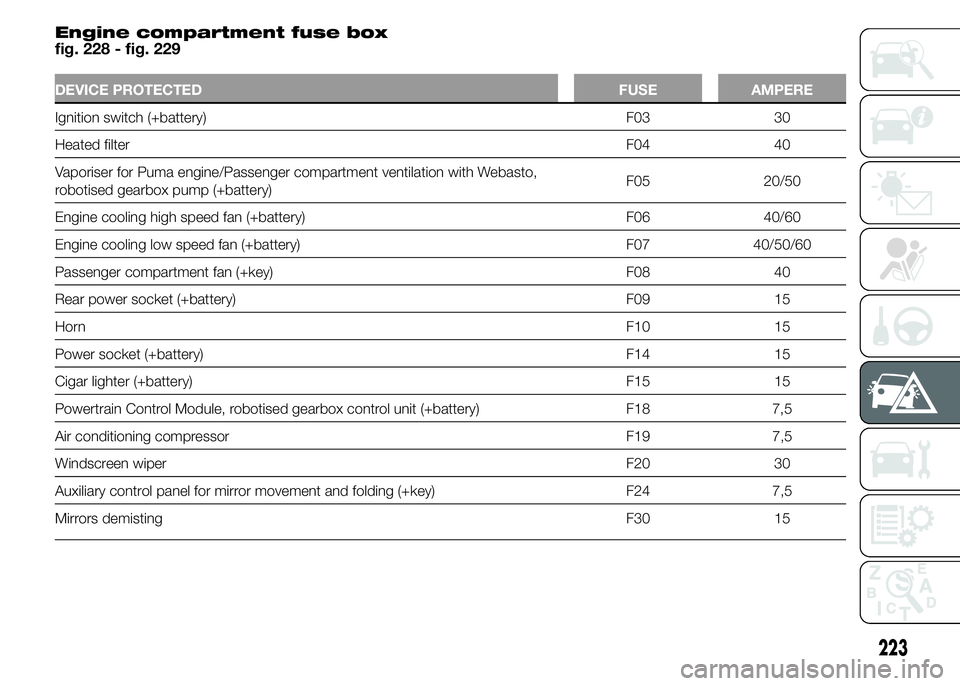
Engine compartment fuse box
fig. 228 - fig. 229
DEVICE PROTECTED FUSE AMPERE
Ignition switch (+battery) F03 30
Heated filterF04 40
Vaporiser for Puma engine/Passenger compartment ventilation with Webasto,
robotised gearbox pump (+battery)F05 20/50
Engine cooling high speed fan (+battery) F06 40/60
Engine cooling low speed fan (+battery) F07 40/50/60
Passenger compartment fan (+key) F08 40
Rear power socket (+battery) F09 15
HornF10 15
Power socket (+battery) F14 15
Cigar lighter (+battery) F15 15
Powertrain Control Module, robotised gearbox control unit (+battery) F18 7,5
Air conditioning compressor F19 7,5
Windscreen wiper F20 30
Auxiliary control panel for mirror movement and folding (+key) F24 7,5
Mirrors demisting F30 15
223
Page 229 of 367
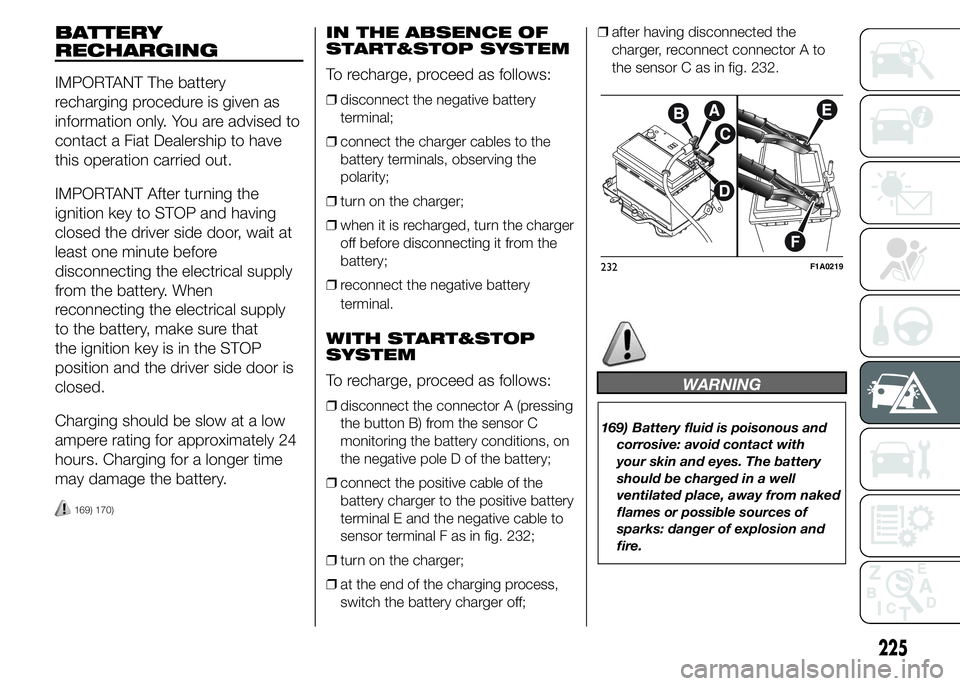
BATTERY
RECHARGING
IMPORTANT The battery
recharging procedure is given as
information only. You are advised to
contact a Fiat Dealership to have
this operation carried out.
IMPORTANT After turning the
ignition key to STOP and having
closed the driver side door, wait at
least one minute before
disconnecting the electrical supply
from the battery. When
reconnecting the electrical supply
to the battery, make sure that
the ignition key is in the STOP
position and the driver side door is
closed.
Charging should be slow at a low
ampere rating for approximately 24
hours. Charging for a longer time
may damage the battery.
169) 170)
IN THE ABSENCE OF
START&STOP SYSTEM
To recharge, proceed as follows:
❒disconnect the negative battery
terminal;
❒connect the charger cables to the
battery terminals, observing the
polarity;
❒turn on the charger;
❒when it is recharged, turn the charger
off before disconnecting it from the
battery;
❒reconnect the negative battery
terminal.
WITH START&STOP
SYSTEM
To recharge, proceed as follows:
❒disconnect the connector A (pressing
the button B) from the sensor C
monitoring the battery conditions, on
the negative pole D of the battery;
❒connect the positive cable of the
battery charger to the positive battery
terminal E and the negative cable to
sensor terminal F as in fig. 232;
❒turn on the charger;
❒at the end of the charging process,
switch the battery charger off;❒after having disconnected the
charger, reconnect connector A to
the sensor C as in fig. 232.
WARNING
169) Battery fluid is poisonous and
corrosive: avoid contact with
your skin and eyes. The battery
should be charged in a well
ventilated place, away from naked
flames or possible sources of
sparks: danger of explosion and
fire.
232F1A0219
225
Page 247 of 367
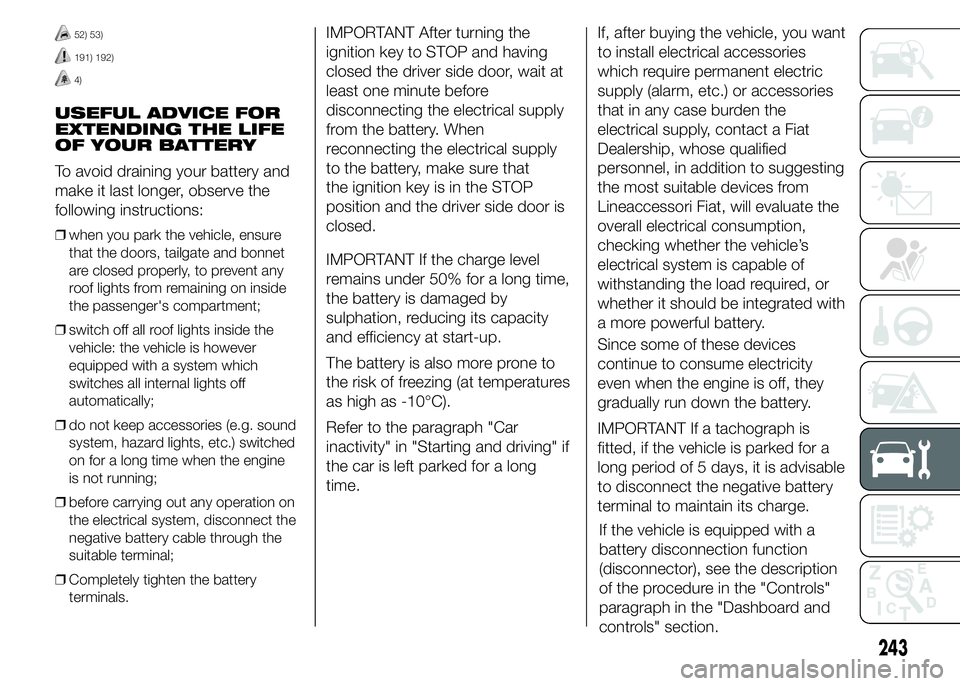
52) 53)
191) 192)
4)
USEFUL ADVICE FOR
EXTENDING THE LIFE
OF YOUR BATTERY
To avoid draining your battery and
make it last longer, observe the
following instructions:
❒when you park the vehicle, ensure
that the doors, tailgate and bonnet
are closed properly, to prevent any
roof lights from remaining on inside
the passenger's compartment;
❒switch off all roof lights inside the
vehicle: the vehicle is however
equipped with a system which
switches all internal lights off
automatically;
❒do not keep accessories (e.g. sound
system, hazard lights, etc.) switched
on for a long time when the engine
is not running;
❒before carrying out any operation on
the electrical system, disconnect the
negative battery cable through the
suitable terminal;
❒Completely tighten the battery
terminals.
IMPORTANT After turning the
ignition key to STOP and having
closed the driver side door, wait at
least one minute before
disconnecting the electrical supply
from the battery. When
reconnecting the electrical supply
to the battery, make sure that
the ignition key is in the STOP
position and the driver side door is
closed.
IMPORTANT If the charge level
remains under 50% for a long time,
the battery is damaged by
sulphation, reducing its capacity
and efficiency at start-up.
The battery is also more prone to
the risk of freezing (at temperatures
as high as -10°C).
Refer to the paragraph "Car
inactivity" in "Starting and driving" if
the car is left parked for a long
time.If, after buying the vehicle, you want
to install electrical accessories
which require permanent electric
supply (alarm, etc.) or accessories
that in any case burden the
electrical supply, contact a Fiat
Dealership, whose qualified
personnel, in addition to suggesting
the most suitable devices from
Lineaccessori Fiat, will evaluate the
overall electrical consumption,
checking whether the vehicle’s
electrical system is capable of
withstanding the load required, or
whether it should be integrated with
a more powerful battery.
Since some of these devices
continue to consume electricity
even when the engine is off, they
gradually run down the battery.
IMPORTANT If a tachograph is
fitted, if the vehicle is parked for a
long period of 5 days, it is advisable
to disconnect the negative battery
terminal to maintain its charge.
243
If the vehicle is equipped with a
battery disconnection function
(disconnector), see the description
of the procedure in the "Controls"
paragraph in the "Dashboard and
controls" section.